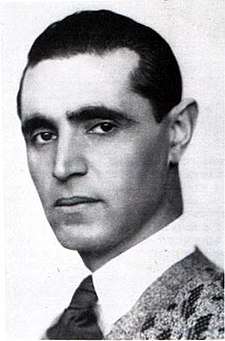Baruch Agadati
Baruch Agadati (Hebrew: ברוך אגדתי, also Baruch Kaushansky-Agadati; January 8, 1895 – January 18, 1976) was a Russian Empire-born Israeli classical ballet dancer, choreographer, painter, and film producer and director.[1][2][3] He is considered a legendary figure in Israeli culture.[4]
Baruch Agadati | |
|---|---|
 Agadati, 1925 | |
| Born | Baruch Kaushansky February 18, 1895 |
| Died | 18 January 1976 (aged 80) |
| Resting place | Trumpeldor Cemetery, Tel Aviv |
| Citizenship | Israeli |
| Alma mater | Bezalel Academy of Arts and Design |
| Home town | Odessa; Tel Aviv |
| Awards | Worthy Citizen of Tel Aviv Award, Municipality of Tel Aviv-Jaffa, 1976 |
Biography
Baruch Kaushansky (later Agadati) was born to a Jewish family in Bessarabia,[5] and grew up in Odessa.[2] He immigrated to Palestine in the early 1900s.[4] In Palestine, he was known for performing Jewish folk dances in an expressionist style.[6]
Agadati attended the Bezalel Academy of Arts and Design in Jerusalem from 1910–14.[4][7] When World War I started in 1914, he was in Russia visiting his parents and was unable to return to Palestine.[8] He remained there and studied classical ballet, joining the dance troupe of the Odessa Opera and Ballet Theater.[9] In 1919, he returned to Palestine. In 1920, he moved to the Neve Tzedek neighborhood in Tel Aviv. Until his death is 1976, he worked in theatre, painted, danced and choreographed Israeli folkdance, produced the famous Purim "Ad DeLo Yada" Carnival balls. He is buried in Trumpeldor Cemetery in Tel Aviv. [4]
Dance and film career
Kaushansky returned to Russia during the First World War and took the name Agadati.[2] After Agadati's return to Palestine in 1919, he began to give solo dance recitals[9] and became one of the pioneers of cinema in Israel.[10][11] Agadati purchased cinematographer Yaakov Ben Dov's film archives in 1934, when Ben Dov retired from filmmaking.[11] He and his brother Yitzhak used it to start the AGA Newsreel.[11][12] He directed the early Zionist film entitled This is the Land (1935), the first Hebrew speaking film, and a new version in 1963, called "Tomorrow's Yesterday.".[13][14]
In the 1920s and 1930s, he was known for organizing Adloyada Tel Aviv Purim balls.[2][4][15]
Agadati's costume for "Yihie" ("Yemenite Ecstasy"), a solo show that also toured Europe and South America, was designed by Natalia Goncharova of Ballets Russes.[16]
In 1924, Agadati choreographed a dance based on the Romanian Hora that became known as "Hora Agadati". It was performed by the Ohel Workers' Theatre, which toured pioneer settlements in the Jezreel Valley.[17] The dancers form a circle, holding hands and move counterclockwise following a six-beat step in a walk-walk-step-kick-step-kick pattern.
Education
- 1910 Bezalel Academy of Art and Design, Jerusalem, with Boris Schatz
- 1914-19 Dance and painting, Odessa
- 1930 Painting, Florence
Teaching
- Odessa, classical ballet, painting and music
Awards and recognition
- 1976 Worthy Citizen of Tel Aviv Award, Municipality of Tel Aviv-Jaffa
Gallery
Archival photographs of Baruch Agadati in costume, taken during the late 1920s.
Photographer: Atelier Willinger, Vienna
Collection of the Bat Sheva and Yitzhak Katz Archive, Information Center for Israeli Art, Israel Museum, Jerusalem
 Baruch Agadati in the Dance "Yemenite Ecstasy"
Baruch Agadati in the Dance "Yemenite Ecstasy" Baruch Agadati as Hassid, from the Dance "Jaffa"
Baruch Agadati as Hassid, from the Dance "Jaffa" Baruch Agadati as Hassid, from the Dance "Melaveh Malka"
Baruch Agadati as Hassid, from the Dance "Melaveh Malka" Baruch Agadati as Hassid, from the Dance "Melaveh Malka"
Baruch Agadati as Hassid, from the Dance "Melaveh Malka" Baruch Agadati as Hassid, from the Dance "Melaveh Malka"
Baruch Agadati as Hassid, from the Dance "Melaveh Malka"
See also
- Cinema of Israel
- Dance of Israel
- Visual arts in Israel
References
- Dalia Manor (2005). Art in Zion: the genesis of modern national art in Jewish Palestine. Retrieved August 5, 2011.
- "Baruch Agadati". Information Center for Israeli Art. Israel Museum. Retrieved 30 October 2016.
- Ruth Eshel (March 1, 2009). "Dance in the Yishuv and Israel". Jewish Women's Archive. Retrieved August 5, 2011.
- Stephanie Fried (March 5, 1993). "What A Party!". The Jerusalem Post. Retrieved August 5, 2011.
- World Union of Jewish Studies (1992). Jewish studies. ha-Igud. Retrieved August 8, 2011.
- Karl Eric Toepfer. Empire of ecstasy: nudity and movement in German body culture, 1910–1935. Retrieved August 5, 2011.
- Art in Zion: the genesis of modern ... Retrieved August 5, 2011.
- "Agadati (Kaushanski), Baruch". Encyclopaedia Judaica. 2007. Archived from the original on November 6, 2012. Retrieved August 5, 2011.
- The Israel Museum journal. 1986. Retrieved August 5, 2011.
- Amos Oz, Barbara Harshav (2000). The silence of heaven: Agnon's fear of God. Princeton University Press. Retrieved August 5, 2011.
- Oliver Leaman (2001). Companion encyclopedia of Middle Eastern and North African film. Taylor & Francis. Retrieved August 5, 2011.
- Stiftung Deutsche Kinemathek (1997). Filmexil. Hentrich. Retrieved August 5, 2011.
- Gary Hoppenstand (2007). The Greenwood encyclopedia of world popular culture, Volume 4. Retrieved August 5, 2011.
- Kronish, Amy; Safirman, Costel (2003). Israeli Film: A Reference Guide. Retrieved December 22, 2015.
- Wendy Luterman (March 2011). "Purim Years Ago as seen in the Movie Archives". Jewish Magazine. Jewishmag.co.il. Retrieved August 5, 2011.
- Ingber, Judith Brin (2011). Seeing Israeli and Jewish Dance. Wayne State University Press. ISBN 0814333303.
- 'Hora' History
- Judaica Reference Sources
- Young Tel Aviv: A Tale of Two Cities - Google Books
- Exhibitions of Baruch Agadati: Painting on Silk. Selfridges Gallery, 1967
External links
![]()
- Baruch Agadati on IMDb
- "Baruch Agadati". Information Center for Israeli Art. Israel Museum. Retrieved 30 October 2016.
- Art of Baruch Agadati at Europeana. Retrieved 30 October 2016
- Hora Agadati dance at Youtube
- The Spielberg Jewish Film Archive - Agadati Screen of an Artist